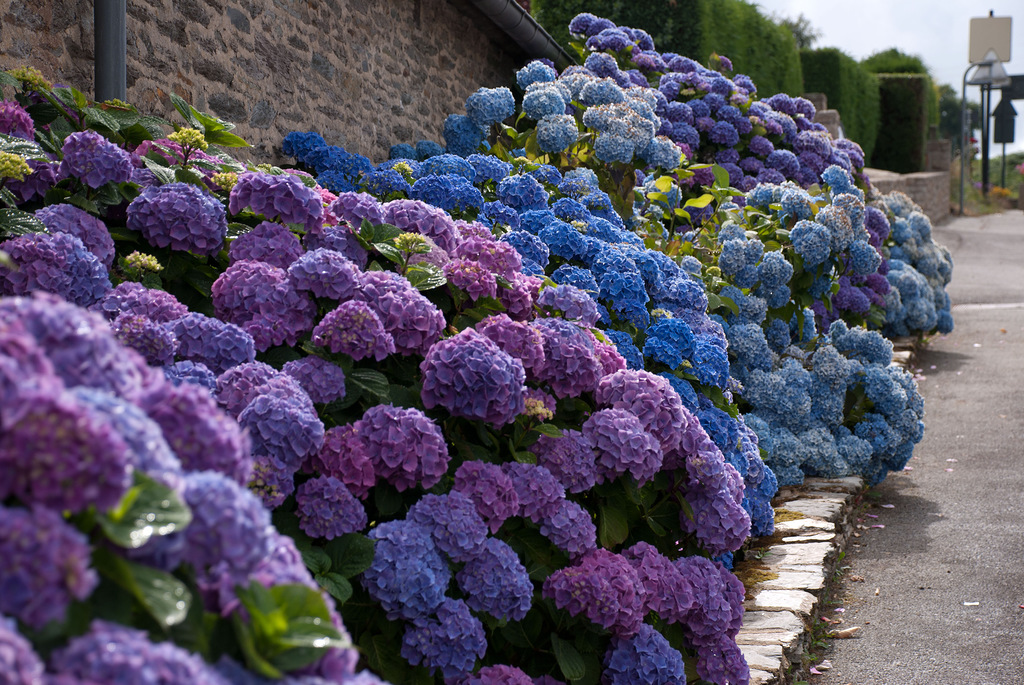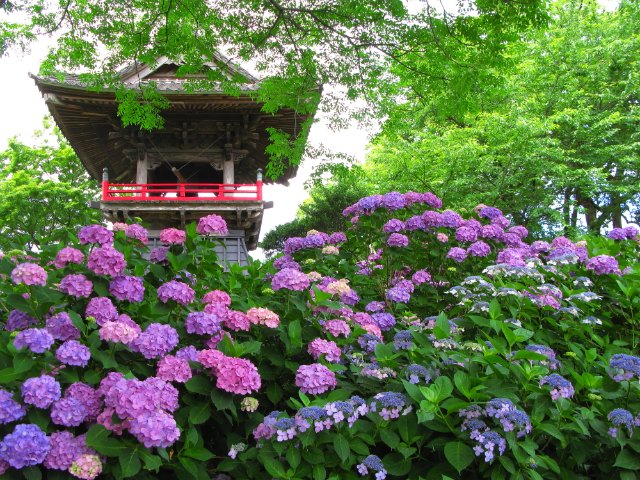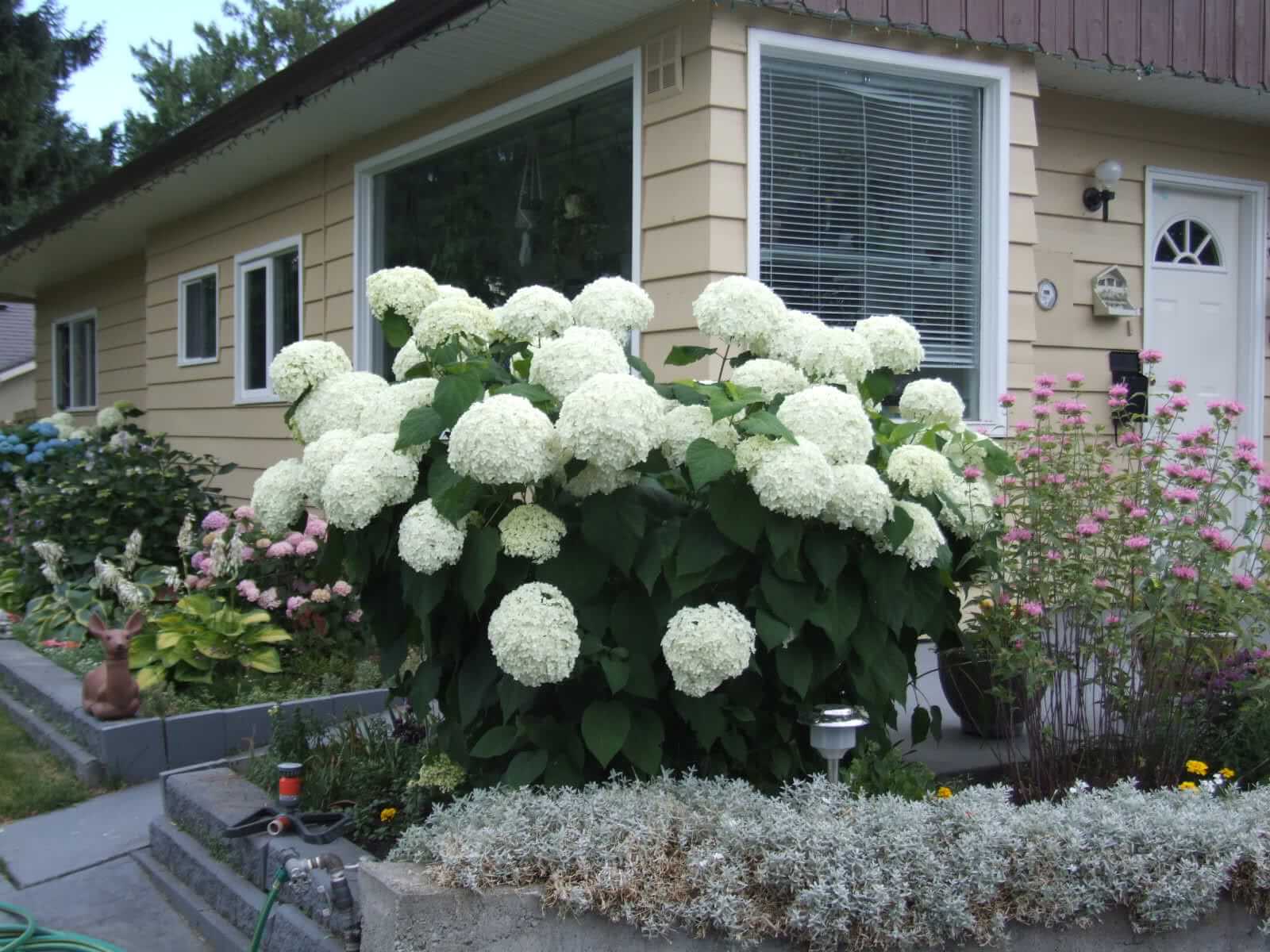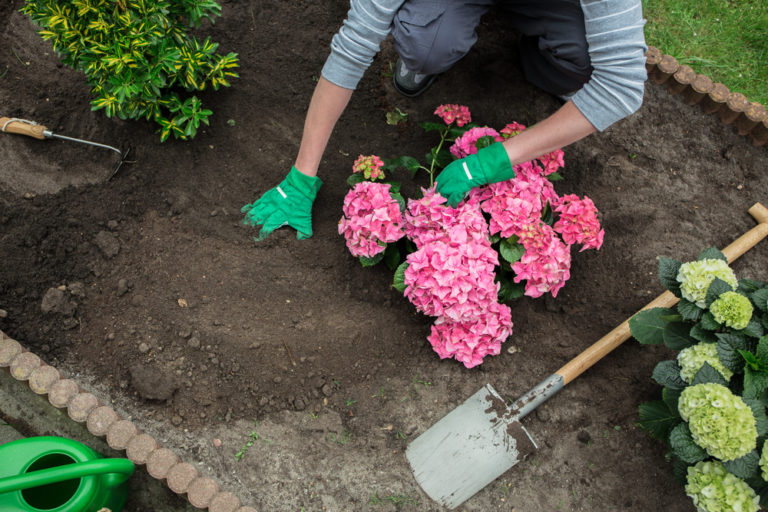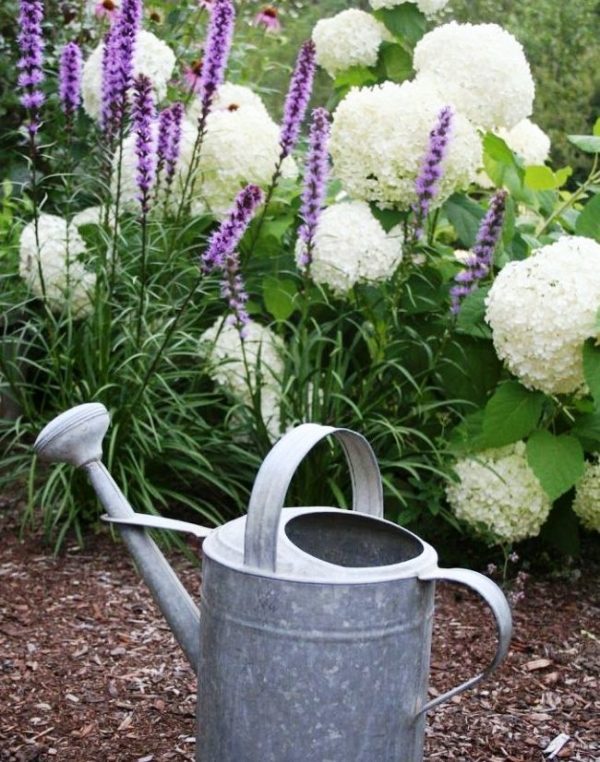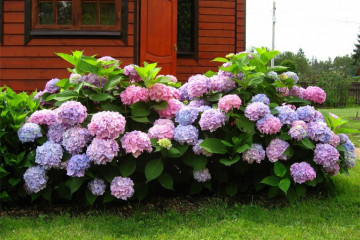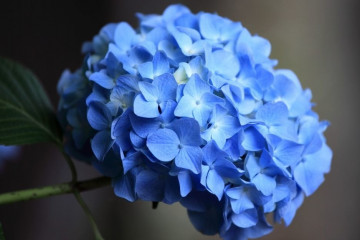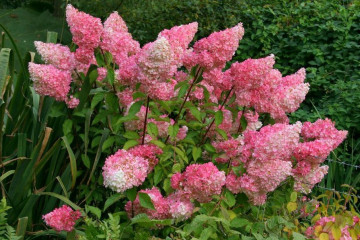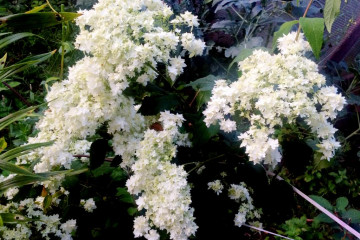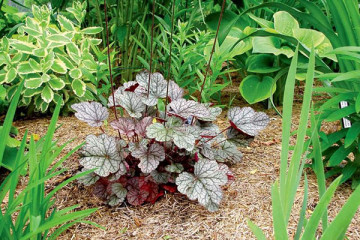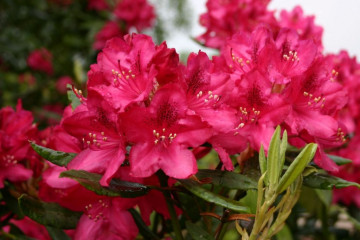Large-leaved or broad-leaved hydrangea - planting and care in the open field
Content:
Large-leaved hydrangea is an ornamental shrub that blooms with lush flowers that resemble a hat in shape. Translated from Greek, the name of the flower is interpreted as "yearning for water." Its inflorescences can be blue, white, blue, purple, crimson or bright crimson. Luxurious leaves and silhouettes enchant almost all gardeners.
Only after planting in the process of growing a plant can you see all the pitfalls. Hydrangeas need careful care and selection of conditions. Therefore, for example, in Siberia, the plant is grown mainly in indoor conditions. It is not suitable for a summer residence or a private house. When grown in the suburbs, tree-like or paniculate varieties are chosen.
The origin and appearance of the plant
This representative of the flora has been cultivated for 20 years. It is used to decorate gardens and create exquisite hedges. More than 60 plant species are known, each of which has unique features. All species are divided into 5 categories: large-leaved, petiolate, ground cover, paniculate, tree-like.
The shrub belongs to the Hortensia family. If the plant is properly cared for, it can reach a height of two meters. In indoor conditions, the maximum height is 60 cm. The flowering period occurs in early summer and lasts until September. Leaves are dark green, oval in shape.
The homeland of hydrangea is Japan, but the plant was brought to Europe from France. This was done by French travelers after a round-the-world voyage. Hydrangea was exported from the island of Mauritius three centuries ago. Not so long ago, the flower was considered indoor, but over time it began to be grown in the open field. The main condition for growing in the open field is care in the winter. Despite the fact that the flower is a heat-loving plant, it tolerates low temperatures. For example, a large-leaved hydrangea can withstand frosts up to 25 degrees.
Types and varieties
In total, there are 80 species of hydrangea with large leaves. Some varieties are grown only indoors, others in the garden. It is worth paying attention to the description of 6 main types that enjoy the well-deserved attention of flower growers.
Macrophile
Hydrangea Macrophylla is a large-leaved plant. This variety has many advantages over other varieties. Bushes reach a height of 4 meters, vines - 30 and more. There are deciduous and evergreen individuals.
The species was brought to Europe from China in 1821. More than 100 hybrid varieties have been bred in 50 years. Many of them feel comfortable only at home, as they cannot stand low temperatures.
The inflorescences resemble a ball. Their color depends on the level of acidity of the soil and can vary from white to dark purple shades. Blooms from June to August. In winter, it can bloom only in closed greenhouses.
Earley Pink
Early Pink hydrangea is considered a novelty among large-leaved varieties.The shrub blooms very beautifully, in height it can reach more than a meter. The Earley Pink hydrangea variety is very hardy, so it is used for cutting or storage in dry bouquets.
Countess Kossel
The large-leaved hydrangea Countess Kossel has an attractive appearance. Delicate pink flowers with a thin red border will look great on the lawn in single or group plantings. The variety does not tolerate low temperatures well, therefore it requires shelter for the winter.
Fiery red
Large-leaved fiery red hydrangea is characterized by large inflorescences with a diameter of 15 to 20 cm. There are flowers of pink, white or blue shades. They can change color during the season. Reproduction of the plant should be done at home using the vegetative method.
Earley Rose
Early Rose is a large-leaved plant that does not tolerate wintering outdoors in Russian climatic conditions. For this reason, it can only be bred at home. A semi-dark place is chosen in the room, protected from drafts and gusts of wind.
General Vomtess De Vibrayi
The plant belongs to tree varieties. This group of plants is considered the fastest growing. In a short time, a large and beautiful shrub can grow from the cuttings. Able to bloom from mid-summer to early September. It stands out with large inflorescences of a beautiful blue hue. Differs in good winter-hardy characteristics.
There are other varieties as well. For example, hydrangea Romance or Joy, which boasts unusually beautiful double pink flowers. Rarely found in Russian gardens, the Blue Bird variety, which has spectacular bright blue flowers. Large-leaved hydrangea Endless summer will delight you with flowering twice a year, which is not typical for all species of this garden plant. It can be called a real miracle of selection.
Open ground transplant
Hydrangea broadleaf is a thermophilic plant. For landing, you need to choose a place that will be protected from direct sunlight and wind.
Seat selection
Hydrangea Macrophila planting and care in the open field are of great importance. The growth of a bush in summer and winter depends on many factors, these are: the regularity of watering, illumination, temperature, humidity, soil composition, fertilizers.
Requirements:
- Lighting. Although the plant loves warmth, you shouldn't plant it under open trees. With excessive exposure to sunlight, the flower will suffer from drying out. If there is too much shade at the planting site, the flora will bloom late. For planting, choose a place where direct sunlight will fall for 6-7 hours a day.
- Temperature. Large-leaved hydrangea is planted in open ground only after the soil warms up, when the threat of frost has completely passed. If the air temperature can reach 10 degrees in spring for a long time, the flower buds will freeze, which will lead to a delay in flowering.
- Priming. It is poorly suitable for shrubs - and moderately acidic soil. There should be no lime in the soil, otherwise the roots will rot. The acidity of the soil affects the color of flowers. This moment cannot be neglected when growing.
- Air and humidity. Young bushes protect from strong winds and spring frosts. For this, the plant is covered with a film or bag for about 14 days. The landing site should be ventilated, but not prone to drafts. Most often, the hydrangea is planted next to the house or along the fence.
Step-by-step planting process
After purchase, the plant is in a small pot. Planting hydrangeas in open ground is performed as follows:
- Fertilizing, digging and clearing the soil from possible pests and weeds during the fall. In the spring, prepare a hole 30 by 30 cm in size.There should be a distance of 100 cm between the bushes.
- In the process of planting, peat is placed on the bottom of the pit (it is not forbidden to use peat soil from packages), mineral and organic fertilizers are added.
- The roots are slightly pruned to the seedlings, after which they are dipped in a previously prepared mixture of clay and earth. A little water is poured into the pit and the stalk is lowered there. It should be positioned so that the root collar does not remain in the ground. It is placed above the soil surface.
- The pit is covered with earth, mulching with peat, compost or humus is performed around it. Cover with foil.
The first shoots should appear in about a month. The film can then be opened. The sprouts should be watered and weeded regularly.
Reproduction of large-leaved hydrangea
Sooner or later, gardeners have a question about how to propagate hydrangea conveniently and effectively. There are two main methods that are worth considering in more detail.
Cuttings
Cuttings are prepared during the pruning period of the plant (in spring):
- shoots with buds are cut in the early morning;
- divide them into two parts, each of which should have buds and leaves;
- for 3 hours, the cuttings are immersed in any stimulant for root formation;
- cuttings are planted in a pot, watered with a little water and covered with jars.
After a month, the plant will give roots.
Growing from seeds
This option is very common. There is one caveat: seeds should be purchased only from trusted producers. To obtain high-quality seedlings, perform the following works:
- Digging up the earth, removing weeds and insect larvae.
- Formation of a high bed. Branches, grass, manure (compost) are placed at the bottom of the dug hole. Next, pour the earth mixed with humus.
- Along the edges they are leveled with a rake, poured with hot water, and covered with a film over the planting. It must be kept for 3 days.
- Seeds are placed on the soil heated in this way, slightly pressing them with your fingers. The garden bed is watered with a little water and covered again.
Growing hydrangeas may differ in different climates. For example, to grow a flower in the Urals, you should choose frost-resistant varieties, since the area is known for cold winters.
Hydrangea care
For hydrangea large-leaved planting and care in the open field play an important role. The grooming should be regular, not from time to time. Attention is focused on watering, feeding, nuances during flowering and dormancy, in preparation for winter.
Watering
Choose soft water (no chlorine and impurities). The best option is rain or standing. Two buckets of water are poured under one bush per week. The flower loves abundant watering. If the leaves sag and curl, the plant lacks moisture.
Top dressing
Fertilizers are applied 3-4 times per season. Flowering is stimulated by feeding with potassium, phosphorus and nitrogen. It is forbidden to bring ash or lime into the ground.
When blooming
Hydrangea is regularly watered, nitrogenous fertilizers are applied every two weeks, formative pruning is performed from the age of 4 in order to rejuvenate the flower.
During the period of rest and preparation for winter
Preparing for rest time includes the following steps:
- removal of leaves;
- tying branches into a bunch;
- high hilling performance;
- the formation of a support for the covering material;
- in cold winters, the plant is completely covered with snow.
Planting a leafy large-flowered hydrangea is half the battle. It is necessary to provide the plant with quality care.When choosing a variety, the climate of the area, the area of the site, financial capabilities and personal desires are taken into account.
